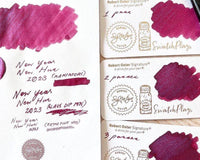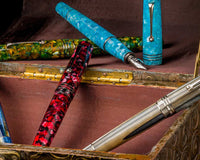Most fountain pens are equipped with standard stock nibs that give writers a smooth writing experience. Whether you choose a fine or a double-broad, you’ll get the same, dependable line from your fountain pen. However, this can also become a little monotonous after some time. Many writers will usually start to look for line variation at some point in their fountain pen journey, and this is where knowing how to grind fountain nibs comes into play.
Why grind your fountain pen nib?
The answer to this question is simple: grinding a fountain pen nib allows you to customize it in such a way that it suits your liking and fits your writing style.
It is worth noting that, generally, the broader the nib when you start grinding, then the more line variation you’ll see after it has been customized. There is definitely a learning curve that fountain pen users will experience when it comes to writing with a customized nib, but it is worth the effort so one can fully express their creativity and style in writing.
How to grind your fountain pen nib

Grinding your fountain pen nib is as simple as reaching out to a nibmeister. While we do not recommend grinding your own nibs without proper guidance from someone more experienced, it is still useful to know what type of grind to ask from your nibmeister depending on your writing preferences.
If you opt for one of the nib customizations below, then you should be prepared to answer several questions from the specialist you consult. Good nibmeisters gather plenty of relevant information before they get to work. They may ask you the following:
- Are you a right-handed or a left-handed writer?
- What is your writing style (cursive or print)?
- How hard do you press down when you write?
- What is your preference for ink flow?
- Is your handwriting small or large?
- How quickly do you write?
- At what angle do you hold your pen relative to the paper?
- Do you rotate your pen as you write?
Nib customizations
Here are the many ways you can grind and customize your fountain pen nibs:
Stub. This is a good place to start for your first fountain pen nib customization. Stub nibs allow you to create broad down-strokes and narrow cross-strokes as you write, which adds some line variation. The edges are a bit more rounded than italic nibs, which we’ll get to.
Italic. The italic is a more demanding nib in that it is more sensitive to the position and angle of the nib relative to the paper. It also creates broad down-strokes and narrower cross-strokes. However, it also provides much crisper lines and more line variation. This is commonly used by calligraphers and artists, but it is still good for everyday writing.
Architect. An architect grind, on the other hand, is squared in the reverse direction of an italic or a stub nib. This allows you to create line variation that is thicker on the cross-stroke and narrower on the down-stroke. This is also a handy customization for writers practicing Hebraic or Arabic calligraphy.
Oblique. Oblique nibs are ground to have the nib at a slant. This creates broad strokes on the diagonal and narrower cross-strokes. This type of grind is very position-sensitive, even more so than the italic nib, as the pen needs to be rotated at an angle to write smoothly.
The Bottom Line
Fountain pen customization can provide writers with a lot of options for their handwriting style and preferences. You can start by grinding a simple stub nib on your own if you feel confident, but otherwise, we highly encourage you to consult with a specialist first.
Happy writing!
Written by EndlessPens Blogger Ramona Kabigting








1 comment
gs
This explanations is not enough unless included a video.